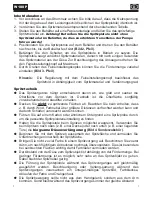
GB
8
W 180P
Materials to be used:
Paints and varnishes containing solvents, acrylic enamel paints, water-soluble
varnishes, glazes, polishes, wood preservatives, disinfectants, plant protectives,
saturants, as well as oils and other watery liquids.
The following spray substances are not suitable for use:
Dispersion and latex paints, materials containing strong abrasives, glazes with coarse
particles, strippers and caustic solutions, silicate paints.
Use of these spray materials can lead to increased wear or corrosion damage in the
pump area, which are not covered by the WAGNER-Guarantee.
Functional Description of the Spray Gun
The spray gun sucks in spray materials. The airless atomisation results when the spray
material is pumped at high pressure through the swirl system and the nozzle bore.
Preparing the Spray Material
The paints usually need to be diluted for use with the spray gun. You will find guidelines
for sprayable dilutions in the following viscosity table (viscosity = consistency of the
paint). You can achieve the correct dilution by using the viscosity test cup.
Measuring the Viscosity
Dip the viscosity test cup
(Illus. 1)
completely into the spray material. Hold the test cup
up and measure the time (in seconds) until the liquid empties out. Compare the
measured "runout time" with the Viscosity Table.
Handling Table for Viscosity
Spray Material
Viskosity:
Large Test Cup
Small Test Cup
Thinner-soluble varnishes/ primers
20-35
20-45
Water-soluble varnishes / primers
20-50
20-60
Automobile spray paint
18-22
18-22
Wood preservatives, disinfectants, plant protectants,
polishes, strippers, oils
undiluted
Hammer effect enamel
25-35
30-45
Aluminium paints
20-30
20-35













































